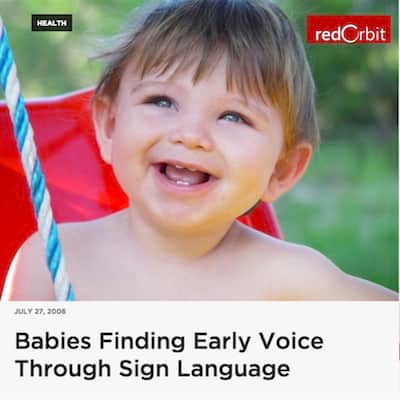LOS ANGELES — Nine-month-old Alexandra lets her mother know when she is hungry. Andrew, 11 months, makes it clear he wants some milk.
They may be too young to speak, but Alexandra and Andrew have joined the growing numbers of hearing babies who are learning sign language to tell their parents what they are thinking.
Once confined to communicating with the deaf, sign language is undergoing a rebirth as a way for new parents to understand the needs of their offspring long before they can talk.
“It is about empowering children to communicate. They can communicate with you at an early age and not be frustrated,” said Etel Leit who runs baby sign language classes in Los Angeles.
Dismissed by some critics as a fad or part of the over-achieving parent syndrome, baby signing is spreading in many parts of the United States but seems biggest in California where it began about seven years ago.
Devotees include actress Debra Messing of “Will & Grace” and a toddler signed with Robert de Niro in the 2004 Hollywood comedy “Meet the Fockers.”
“The biggest interest is in California. People in California love new and interesting things,” said Professor Deena Bernstein, head of speech language hearing sciences at Lehman College in New York.
Books, flashcards, videos and classes hail the benefits of teaching babies as young as 6 months old to sign with their parents, promising improved IQ, accelerated speech development and less frustration for everyone during the “terrible twos.”
Leit spent 16 years as a language teacher before setting up her own signing business and says she is getting workshop requests from daycare centers and playschools.
DEALING WITH DIAPERS
On a Monday morning in west Los Angeles, Leit lead a handful of mothers, babies and some of their nannies in an hour-long class featuring action songs, games and the week’s special topic — “dealing with diapers.”
The infants — around a year old — looked mostly bemused or laughed as their mothers wiggled their hands and fingers to make gestures for “diaper,” “wet,” “dirty” and “clean.”
Some mothers are meeting opposition from older relatives who feel the classes will delay language development. Leit, however, stresses combining signing with talking to one’s baby rather than replacing speech with signs.
And she has some encouraging success stories, like the one about the mother who went into her crying 13-month-old at night and the child signed that she was scared. A car alarm was blaring outside and when the window was closed the child went back to sleep.
“The mom would never have realized that without signing because at 13 months a child can’t say, ‘I’m afraid’.” said Leit.
‘NEW FAD’
Psychology professor and mom Susan Murphy said she joined the class because of research that suggested signing reduces frustration. “Andrew (11 months) is also very active and I think he has a lot to say,” she added.
Liza Roser Atwood has spent years working with deaf children and wanted her own hearing daughter Alexandra, 9 months, to reap the benefits.
“She makes the sign for ‘eat’ so I know when she is hungry and when I make the sign for ‘daddy’ she turns round and looks back,” she said.
Professor Bernstein is skeptical of some of the loftier claims. She said more scientifically controlled evidence was needed to persuade her that signing alone accelerates intellect or language development any more than long periods of one-on-one attention, reading and stimulating play.
“I find that people in Los Angeles try to hook on to any new fad that comes along. They also have the money for it. You are not going to find this in areas where there is poverty,” Bernstein said.

